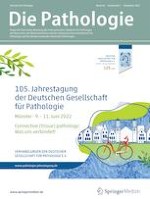Erschienen in:

29.09.2022 | Zielgerichtete Therapie | Hauptreferate: Hauptprogramm der DGP
Chordome – Ein Update
verfasst von:
K. Mellert, C. Seeling, P. Möller, Prof. Dr. med. T. F. E. Barth
Erschienen in:
Die Pathologie
|
Sonderheft 1/2022
Einloggen, um Zugang zu erhalten
Zusammenfassung
Chordome sind seltene, maligne Tumoren des Achsenskeletts mit notochordaler Differenzierung. Morphologisch können sie eine erhebliche Bandbreite von der klassischen, konventionellen Form über hepatoide und nierenzellkarzinomähnliche Varianten oder auch niedrig differenzierte und dedifferenzierte Formen aufweisen. Der Nachweis von Brachyury als immunhistologischer Marker ist ein wesentliches, wenn auch nicht exklusives diagnostisches Merkmal. Die Differenzialdiagnose zum benignen notochordalen Tumor (BNCT) erfordert neben der Morphologie zwingend die Einbeziehung der Bildgebung, da der BNCT auf den Wirbelkörper beschränkt bleibt und nicht osteolytisch imponiert. Zielgerichtet Ansätze für die Therapie sind im Fokus der Forschung und Zelllinienmodelle eine der Voraussetzung dieser zunächst in-vitro-basierten Ansätze.